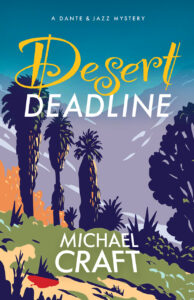More than any other variant included under the umbrella of “crime fiction,” mystery novels embody a straightforward setup of the conflict-and-resolution components of storytelling. The conflict is murder. The resolution is naming whodunit. Everything in between—the rising and falling action, the crises and complications, the revelations and setbacks—all of that can be summed up as the investigation.
A murder mystery, by its nature, is highly plot-centric, and the plot will typically be complex, with a large cast of characters, written with keen attention to detail.
I’m surely not alone in observing that in some circles—particularly literary and academic circles—plot-driven fiction is considered antiquated and two-dimensional, while character-driven stories are seen as the more worthy goal of any serious writer.
Well, now. We know where that can lead, right? Nonstop introspective angst. Interminable dialogue on the meaning of life. Or “action” that’s limited to sneers and unflinching stares. Uh, no thanks.
The obvious workaround is compromise—a concept that might seem anathema to the world of polarized politics. But in the world of storytelling, readers rightfully expect a compelling and engaging plot that is also fleshed out with fully developed three-dimensional characters. Any good, solid, modern novel needs both.
So the primary plot of a mystery novel—the puzzle, the whodunit—can benefit greatly from the addition of complementary subplots, in which the focus temporarily shifts from crime solving to character development. Often, the dominant subplot deals with romance, and in a mystery series, that subplot can provide an overarching link that carries the protagonist from book to book.
In my own writing, each series installment is necessarily defined by a distinct, stand-alone whodunit, which I think of as the “action plot,” while the series as a whole is united by the secondary arc of what I call the “emotion plot,” which might deal with romance or health or parenthood or any other issue that allows a deep examination of the protagonist and other main characters.
In addition to these fully developed subplots, I like to employ the use of lesser subplots, which I think of as “plot filaments.” Unlike the dominant subplot, these are not planned in advance while outlining the book. Rather, I allow these plot filaments to arise creatively and organically during drafting, as suggested by the story in progress. They often serve character development, but sometimes they merely lend texture and depth to the story because they are interesting, humorous, or curious. These filaments resemble mini-plots in that they take place over time and want to be resolved, or at least “explained,” and in fact, they are all dispatched before the climactic reveal of the central whodunit.
For example, in Desert Deadline, my recent second installment of the Dante & Jazz mystery series, at least four quirky plot filaments evolved during drafting of the book: a neighbor’s noisy dog, a monumental Inca statue, a Parsons table, and a bizarre incident involving a pitcher of ice water. My intention with these was to add layers of “sense detail” and perhaps create a bit of wonder—good things in a mystery.
While the dominant subplots of any given book should ideally advance the central plot and eventually dovetail with it, my notion of the lesser plot filaments has a different, more subtle function. These filaments don’t need to advance the main plot, but they do play a role in supporting it by piquing and maintaining the reader’s interest.
Consider, for example, the overall structure of a murder mystery. It has a beginning, a middle, and an end—directly analogous to a classically plotted three-act play. In my more recent novels, I have stopped tinkering with structure and have fully embraced this tradition, dividing the story into three titled “parts.”
Part One contains the murder (or the discovery of the body). Some writers like to open with a bang by placing the murder up front, on page one, but I place the murder at the end of Part One, as it provides such a natural climax. This also allows the introduction of a field of suspects prior to the death, when we can see firsthand their interaction with the victim-to-be. Part One occupies fewer than a third of the book’s total pages.
Part Two is considerably longer, the longest section of the book, containing the nuts and bolts of the investigation, with its shifting suspicions, planted clues, and the subterfuge of red herrings (it’s a game, remember). Part Two ends with a climax that seriously raises the stakes—another murder or an attempt on the sleuth’s life or, as in Desert Deadline, a calamity befalling someone near and dear.
Part Three, the shortest section of the book, is the rush to solve everything in the penultimate chapter, which contains the showdown, followed by a brief closing chapter (sometimes treated as an epilogue), in which we see normalcy restored.
Although Part Three will feel driven—as if self-propelled—in its focus on resolving the central murder plot, it is not in the nature of Part One or Part Two to be carried along by that sort of baked-in dynamic. Aristotle himself wrote of “rising and falling action,” acknowledging that a story cannot be continuously in high gear. Nonetheless, novelists in training are always warned of the pitfalls of “middles that sag.”
It can be a long haul from one natural climax point to the next. Therefore, in writing a mystery—during the setup for the murder in Part One and during the subsequent investigation in Part Two—it’s an intrinsic challenge to keep the reader engaged and turning pages and wondering what’s next.
And that’s where the insertion of subplots and incidental plot threads can truly shine. In the foreground, you’re pulling the strings and pressing the levers of righting the wrongs of deadly mischief. But in the background, you’re performing some sleight of hand, holding the reader’s interest, layering the story with unexpected little mysteries, maybe coaxing a few laughs. That monumental Inca statue, for example, found in a guesthouse—he’s ten feet of stone fertility god, his phallus thick as a baseball bat with a beach towel hanging from its cantaloupe-size knob.
All in the pursuit of justice, of course.
*





















